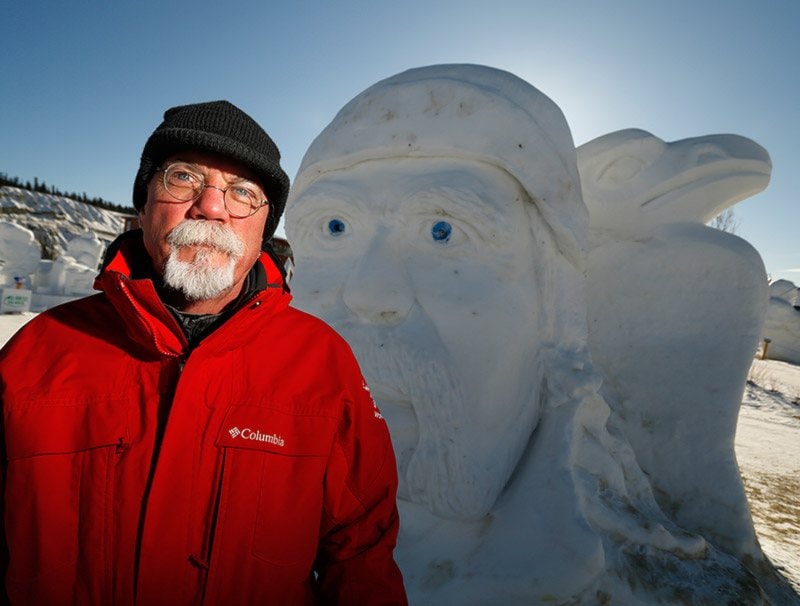One of the territory’s most famous snow carvers is taking a step back from the international snow carving competition he’s been running for the past 14 years.
But he’s not hanging up his chisels just yet.
Donald Watt started the Whitehorse International Snow Sculpture Challenge in 2002.
Every year since he’s worked on grant applications, booked plane tickets and accommodations for the carving teams, taken care of the teams during the challenge and written grant reports.
In the end all the paperwork and administrative tasks took time away from his passion. While he ran the snow carving competition, Watt himself couldn’t compete.
“I spent an awful lot of time being an administrator, not an artist,” Watt said.
“I’m changing my focus,” he said. “I hope to have a successful year with my own art.”
The recent passing of his close friend and snowcarving teammate Michael Lane in early January also made him think.
“I’m missing him a lot,” said Watt. Lane was one of the few people who worked to launch the Whitehorse carving competition.
“I’m (also) thinking about my own mortality,” said Watt. “It is time I do more of my own art.”
Art is what Watt has pursued all his life.
In high school he dropped the science classes for the art ones. In Grade 9, his art teacher asked students to go outside and sculpt snow piles around Prince George, B.C.
At the University of Manitoba he studied sculpture and printmaking. After that he started working for a theatre, designing stage props.
He got married, became a father, and landed a job with the federal government that brought him to Whitehorse in 1980.
At the time there was no international snow carving challenge and the Yukon Rendezvous festival organized its own little competition, open to any Yukoners.
From there Watt’s passion snowballed into an international career. He first represented the territory in Quebec City in the ’80s, and then represented Team Canada.
For about 30 years he represented the country at international competitions, winning awards at the Quebec City Winter Carnaval International Snow Carving Competition seven times between 2001 and 2014.
He and his team travelled to Japan, the United States, Italy, China and Switzerland.
At the height of their career, Watt and his teammates would do eight sculptures in eight weeks, starting early in the year in order to be back in Whitehorse to run the snow carving competition.
“It would be awesome, just to make that much art in that short period of time,” he said.
“Those huge pieces. That was the rush.”
The motto of his team could have been “carve snow, see the world.”
“Well, seeing airports, hotels and parks,” Watt said jokingly.
Because snow carving events tend to happen on the weekend, Watt and his team had time to explore the towns they were visiting.
“We got to see some interesting parts of the world,” he said.
Watt says he’s already told the board of the Whitehorse International Snow Sculpture Challenge of his imminent retirement from the organization.
His first order of business: carve out some space in his own studio.
“It’s pretty full of stuff,” he said.
From the snow carving competition hospitality packages that ended up in piles there, to the regular home clean-ups that meant more clutter shoved in his studio, there’s work to do.
So far Watt already has a sculpture exhibition planned for May in Carcross — clay and papier maché — and is working on two dance shows for which he is designing the stages.
He also designed the stage for the gory comedy Evil Dead: The Musical currently playing at the Guild.
Watt isn’t sure yet if he will be back on the snow carving scene anytime soon.
It’s teamwork, he said, which requires compromises in the design and the work process.
“Sometimes I like creating my own piece of work with my own intentions and my own twist on it,” he said.
The loss of Lane, with whom he first started carving in the 1980s, also changed the situation.
Watt will still showcase his work, he said, like he’s been doing in Lake Louise, Alta., for the past two years.
One thing is sure — the passion and the wonder he first felt when he started snow carving are still there.
“In every block of snow there is a sculpture waiting to be discovered,” he said. “There is all that potential of creativity that’s just sitting there.”
He has fond memories of watching other teams carve during the Whitehorse competition despite working 20-hour days to run the festival.
“It was still awesome,” he said, “to work for those artists, to watch them with the northern lights dancing overhead.”
Snow sculptures are probably the art form most susceptible to the passage of time.
“As soon as you stop working it starts to deteriorate: the edges soften, the sun starts to rip it apart, (if) the temperature rises and it begins to melt.”
But there was always that one minute, after the sculpture was finished and before it started to melt away, when the artists could take a step back and admire their work.
“For that one minute when you put your tools down, and you sweep away the extra snow and step back and you whip out your almost frozen camera and take a few pictures,” Watt said, “it’s awesome.”
Contact Pierre Chauvin at pierre.chauvin@yukon-news.com
